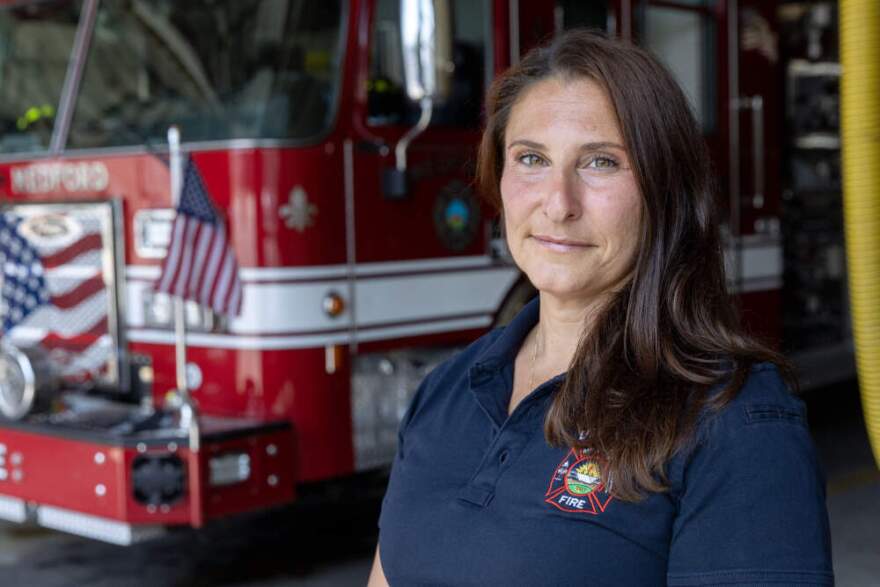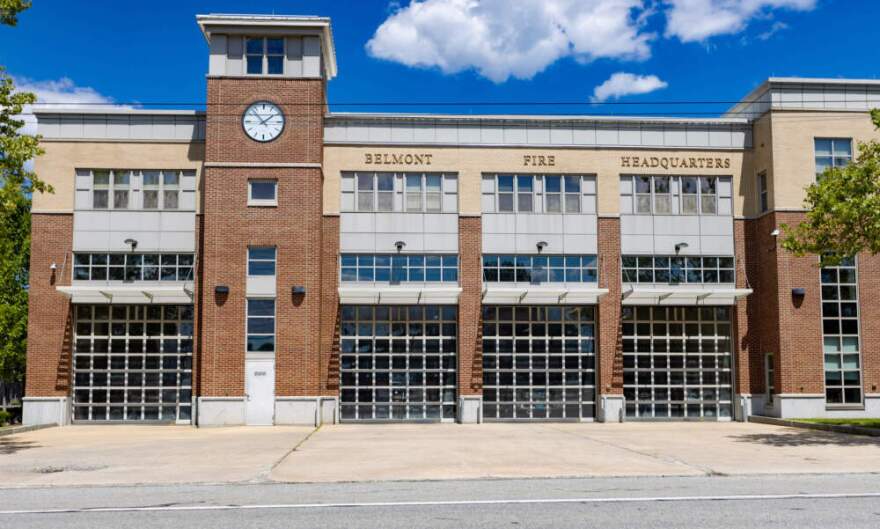Nearly all Massachusetts fire departments fail to meet national standards for staffing fire trucks, based on a survey of local unions launched after the deadly Fall River fire.
Firefighters across the state say they’re worried they don’t have enough people to handle the next big fire.
“It’s putting the public in jeopardy. It’s putting firefighters in jeopardy,” said Rich MacKinnon, president of Professional Fire Fighters of Massachusetts, which put out the survey and shared it with WBUR.
The minimum standard set by the National Fire Protection Association, a nonprofit that develops safety protocols, is four on-duty firefighters per engine or ladder truck when responding to a fire. MacKinnon said there are a lot of fire departments only staffing trucks with two people.
“We’re severely understaffed,” Medford Fire Department Lt. Danielle Marcellino told WBUR.
The city’s fire department staffs three firefighters on each truck. That’s “less than the bare minimum,” she said, for dealing with Medford’s numerous high-rises, apartment buildings and facilities for seniors and other vulnerable residents.

A fundamental rule of firefighter safety, Marcellino said, is that you need four firefighters to attack a fire.
“If we send two members into a burning building, there are two members outside to back us up. God forbid something goes sideways,” said Marcellino, who serves as the department’s union president.
WBUR asked the Medford mayor’s office if it had concerns about staffing and safety. The office said “no” and added that current levels are based on the latest collective bargaining agreement.
Firefighter staffing levels are under scrutiny after the fire at the Gabriel House assisted living facility earlier this month. Ten people died and more than 30 were injured.
At the time of the fire, only two of Fall River’s 10 engine and ladder trucks that responded to the fire met the national standard. Representatives from a national firefighter’s union have claimed the lack of personnel played a role in the high death toll.
In response, Gov. Maura Healey announced $1.2 million to help Fall River hire 15 to 20 firefighters in the next two years to raise staffing closer to the national standard.
While there’s no tracking of each department across the country, short staffing is not just a Massachusetts problem.
“The staffing issues in Fall River aren’t just a Fall River problem,” said Edward Kelly, president of the International Association of Fire Fighters, at a recent press conference in Fall River. “They are in places all over Massachusetts and beyond.”
In the aftermath of the fire, the Professional Fire Fighters of Massachusetts reached out to its local unions in 237 fire departments to find out their minimum staffing levels based on collective bargaining agreements or department policies. The survey asked how many people are assigned to trucks and ladders.
Of the 182 unions that responded to the survey, only three departments — Boston, Brookline and New Bedford — staff both their engine and ladder trucks with four firefighters each.
Many firefighters also left notes in the survey about the challenges they face at their departments. At smaller stations, firefighters said understaffing means fire stations can be left unmanned — particularly when firefighters are “cross-staffed” to also serve on ambulances for medical calls.
In Hadley, a town of about 5,300, the fire department has two firefighters on-duty at any one time, but “when that ambulance goes out the door, that leaves zero firefighters available,” wrote firefighter Michael Mazulis in the survey.
Hadley is home to a skilled nursing facility, two elderly housing complexes and two malls.
“We are understaffed,” Mazulis stated. “All we’ve been thinking about is what happens when a fire like the Gabriel House fire happens at one of our elderly housing facilities.”
To finance more firefighters often means an increase in taxes.
For smaller towns in the state, it can be even more of a challenge to fund fire departments so that they meet the standards, according to Michael Boynton, town manager of Medway — a community of about 13,000 people.
He said there’s “no way” Medway could afford to staff four firefighters on both engines and ladder trucks — and also cover ambulance calls.
To meet the standard, Medway would have to double the number of firefighters. “So that’s not, that’s not realistic for us” financially, Boynton said.
Instead, the town relies on personnel to cover both fire and medical calls as well as mutual aid agreements with neighboring towns to help respond to emergencies. While smaller towns don’t deal with the same types of fires and call volume as bigger cities like Fall River, he is pushing to increase staffing for his fire department.
“The union’s concerns are not unfounded,” Boynton added.

Belmont, a densely-populated town outside Boston, has three firefighters on fire engines and only two on ladder trucks, according to the survey response. An unnamed firefighter said in the survey that they worried about the town’s new construction of apartment buildings — and what would happen in a fire. Belmont’s town manager didn’t return an email seeking comment.
For many firefighters, what happened in Fall River is a wake-up call.
Lorenzo Sordoni, a firefighter in the small town of Templeton, told WBUR his department staffs only two on-duty firefighters for a shift and they’re required to deal with both fire and medical calls. His town is small and rural, but — like Fall River — there are nursing facilities, rehab centers and group homes.
“There’s a very real possibility that you’d see the same thing that happened in Fall River happen in Templeton,” he said in an interview with WBUR.
His message in the survey about staffing levels was blunt: “Absolutely unsafe and will cost lives.”
This article was originally published on WBUR.org.
Copyright 2025 WBUR

